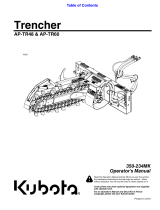
2
The T
oro Company
– 1999
8111 Lyndale Ave. South
Bloomington, MN 55420–1196
All Rights Reserved
Printed in the USA
Contents
Page
Introduction 2.
. . . . . . . . . . . . . . . . . . . . . . . . . . . . . . . .
Safety 2
. . . . . . . . . . . . . . . . . . . . . . . . . . . . . . . . . . . . . .
Safety Decals
3
. . . . . . . . . . . . . . . . . . . . . . . . . . . . .
Specifications 4
. . . . . . . . . . . . . . . . . . . . . . . . . . . . . . . .
Stability Ratings
4
. . . . . . . . . . . . . . . . . . . . . . . . . . .
Installation 4
. . . . . . . . . . . . . . . . . . . . . . . . . . . . . . . . . .
Installing the Drive Head on the T
raction Unit
4
. . .
Connecting the Hydraulic Hoses
5
. . . . . . . . . . . . . .
Installing Accessories
5
. . . . . . . . . . . . . . . . . . . . . . .
Removing an Accessory
6
. . . . . . . . . . . . . . . . . . . . .
Removing the Drive Head from the T
raction Unit
6
Operation 6
. . . . . . . . . . . . . . . . . . . . . . . . . . . . . . . . . . .
Digging the T
renches 6
. . . . . . . . . . . . . . . . . . . . . . .
Boring the Hole
6
. . . . . . . . . . . . . . . . . . . . . . . . . . .
Reaming the Hole
7
. . . . . . . . . . . . . . . . . . . . . . . . . .
Maintenance 8
. . . . . . . . . . . . . . . . . . . . . . . . . . . . . . . . .
Storage 8
. . . . . . . . . . . . . . . . . . . . . . . . . . . . . . . . . .
Troubleshooting 8
. . . . . . . . . . . . . . . . . . . . . . . . . . . . . .
Introduction
W
e want you to be completely satisfied with your new
product, so feel free to contact your local Authorized
Service Dealer for help with service, genuine replacement
parts, or other information you may require.
Whenever you contact your Authorized Service Dealer or
the factory
, always know the model and serial numbers of
your product. These numbers will help the Service Dealer
or Service Representative provide exact information about
your specific product. Y
ou will find the model and serial
number on a plate located on the right side of the drive
head.
For your convenience, write the product model and serial
numbers in the space below
.
Model No:
Serial No.
The
warning system in this manual identifies potential
hazards and has special safety messages that help you and
others avoid personal injury
, even death. DANGER,
W
ARNING and CAUTION are signal words used to
identify the level of hazard. However
, regardless of the
hazard, be extremely careful.
DANGER
signals an extreme hazard that will cause
serious injury or death if the recommended precautions
are not followed.
WARNING
signals a hazard that may cause serious injury
or death if the recommended precautions are not followed.
CAUTION
signals a hazard that may cause minor or
moderate injury if the recommended precautions are not
followed.
T
wo other words are also used to highlight information.
“Important” calls attention to special mechanical
information and “Note” emphasizes general information
worthy of special attention.
The left and right side of the machine is determined by
sitting on the seat in the normal operator
’
s position.
Safety
Impr
oper use or maintenance by the operator or owner
can r
esult in injury
. T
o r
educe the potential for injury
,
comply with these safety instructions and those in the
traction unit Operator
’
s Manual. Always pay attention
to the safety alert
symbol, which means CAUTION,
W
ARNING, or DANGER—“personal safety
instruction.” Failur
e to comply with the instruction
may r
esult in personal injury or death.
DANGER
POTENTIAL HAZARD
• Ther
e may be buried power
, gas, and/or
telephone lines in the work ar
ea.
WHA
T CAN HAPPEN
•
Shock or explosion may occur
.
HOW T
O A
V
OID THE HAZARD
•
Have the pr
operty or work ar
ea marked for
buried lines and do not dig in marked ar
eas.











